► Peugeot 308 hatchback all-new for 2021
► Hybrid, electric, petrol and diesel power
► Hear from CEO, designers and project boss
Bigger yet more fuel-efficient, electrified and with a new-generation of tablet-inspired infotainment, this is Peugeot’s all-new 308. And it remains an unapologetic, five-door hatchback – unlike its Citroën C4 and DS 4 Cross sister cars, with their vogueish ‘crossover’ influences.
‘The new 308 is the first vehicle with the new face of Peugeot,’ says Linda Jackson, the brand’s new CEO. ‘It has our best level of quality, new i-Cockpit which enhances the on-board experience, and efficiency was an over-riding priority of the project team.’

The new hatch goes on UK sale in early 2022, priced from £24,000, along with an SW estate that costs a £1200 premium. Power comes from petrol, diesel and hybrid engines.
But there’ll also be a pure-electric version too in 2023. ‘We have a road map that will introduce mild-hybrid engines and battery-electric [power] in the 308,’ confirms project leader Jerome Micheron. Expect the car to have a range close around 230-240 miles.
It’s a crucial step, as the Stellantis group (formerly known as PSA until its recent merger with Fiat Chrysler) seeks to roll-out larger EVs than today’s 208 supermini, 2008 compact SUV and the aforementioned e-C4 (which uses a different platform, CMP, despite being just 12mm shorter).
WATCH OUR VIDEO GUIDE TO GOING ELECTRIC, WITH PEUGEOT’S e-2008
All-new car? The design theme feels familiar…
There’s nothing too unexpected about the 308’s look: the LED fangs, shiny grille accents and rear claw lamp details are familiar from other Peugeots, and the side profile is remarkably faithful to the outgoing car’s, with its sail-shaped rear pillar devoid of any quarterlight and a strong swage line leading to the rear lamps.
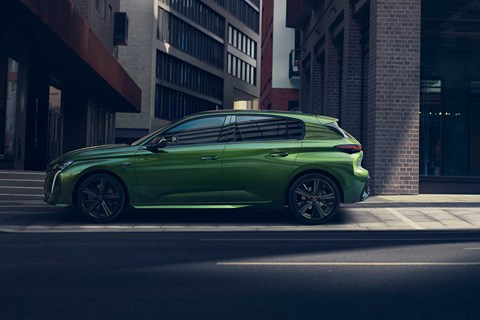
But the package has been seriously overhauled. ‘It’s part of our move upmarket: we worked hard to get the proportions right,’ says new design head Matthias Hossann. He took over from Gilles Vidal last year, but in his former role as head of advanced design Hossann kickstarted the package and proportions.
So, as with the 508 Fastback, the windscreen is at a more rakish angle and set farther back to accentuate the bonnet, and the 16-18-inch wheels are pushed towards the edges of the platform. This boosts the wheelbase by 55mm and increases rear space (particularly kneeroom), and accounts for half of the 110mm increase in vehicle length to 4367mm overall. The new 308 is slightly lower too (though not as low as the speedbump-scraping front number plate), which makes for a more dynamic shape.
The new Lion emblem roars and roars
‘A key challenge was to showcase the new Peugeot [Lion] emblem,’ explains Hossann. ‘We made sure everything was built around the logo, that’s why we moved down the number plate. The larger grille ensures the new emblem is visible for the customer.’ Job done, but just in case you miss it, the logo is repeated on both front wings, as well as the boot.

Fellow designer Pierre-Paul Mattei shared an interesting aside: a little of the 308’s additional length is due to the vast new grille extending beyond the frontal impact beam. And amusingly, 80% of the design proposals starting the new 308 project included the new Lion logo, first shown on 2018’s e-Legend concept, even though no decision had been taken to adopt it at that time. It seems the designers’ tail wagged the corporate lion into action.
The boot will stow a generous 412 litres (though unusually that’s down on its predecessor), which dips to a still competitive 361 litres on hybrid models. Oh, and that distinctive launch colour is Olivine Green, by the way; six other shades will be available. But there’s no mention of that two-tone roof business that livens up many a configurator.
Smooth shape, slippery aero
Lots of attention has been paid to aerodynamics: the pronounced, Audi-esque wheelarches do not require a wider track, which would bloat the frontal area. There’s a longer rear spoiler to smooth airflow, and the bumpers, mirrors and underbody protection have all been optimised to reduce drag. The co-efficient of drag is 0.28, slippery but marginally behind the current Ford Focus.
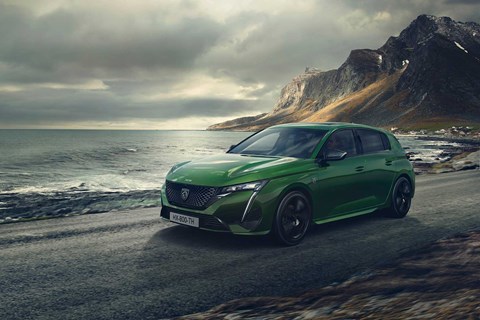
Peugeot is talking up the car’s refinement. The body structure is significantly stiffer, thanks to the chassis being bonded and welded, while thicker glass keeps noise at bay. Despite being bigger, the car is no heavier thanks to the latest version of EMP2.
What is Peugeot saying about efficiency and engines?
The combustion-engine line-up comprises the tried and trusted 1.2-litre, three-cylinder petrol, and the 1.5-litre, four-cylinder diesel. The petrol engine produces 110PS (108bhp) or 130PS (128bhp), with the latter power output the same as the diesel’s. In mainland Europe there’s a choice of six-speed manual or eight-speed auto, but the UK is only getting the higher power engines with that auto box.
For the petrol engine, carbon dioxide emissions start at 122g/km, and 43-52mpg. And they should get better in time: 48-volt mild-hybrid assistance is in the pipeline.
Okay. But Boris tells me I need to be going electric…
At launch you have two front-wheel-drive plug-in hybrids to pick from, badged Hybrid 225 or Hybrid 180. In either case the combustion engine is a 1.6-litre turbocharged petrol, producing either 148bhp or 177bhp, and paired with an 81kW electric motor, sandwiched between the engine and eight-speed automatic gearbox.
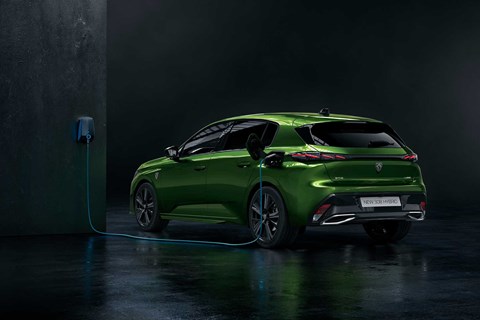
The punchier Hybrid 225 offers 26g/km of CO2 and 59km of electric range (36 miles); lop off a gramme and add a km to get the Hybrid 180’s marginally more flattering figures. Both systems are fed by a 12.4kWh lithium-ion battery, which takes just under two hours to charge from a 7kW wallbox, or roughly seven hours from a domestic plug.
Peugeot claims the hybrids will offer near cost-parity with the combustion-engine cars, due to a better secondhand value, fiscal incentives and a 12% efficiency advantage over 56,000 miles/three years compared with the diesel.
Inside the new 308: where the wild things are
The biggest change is the all-new infotainment system, called i-Connect. Peugeot is the latest manufacturer to adopt a ‘tile’ approach on the standard 10-inch central touchscreen, where drivers can choose their favourite widgets to customise different pages. The safety-conscious will be disappointed that the screen has swapped places with the air vents and sits lower, but Peugeot says that’s to make it more reachable.
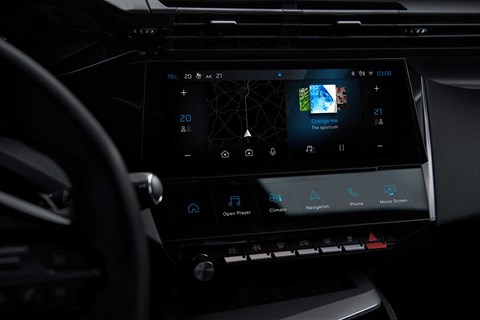
Beneath the screen, there’s a panel of digital ‘i-toggle’ switches which provide a shortcut to the driver’s most valued functions, such as favourite radio stations, telephone contacts, navigation destinations and air-con settings. Physical blower and temperature buttons are absent, though there are switches for demisting the glass screens, air recirculation and calling up the digital climate controls.
Up to eight driver’s profiles and infotainment settings can be established, and two phones linked simultaneously and wirelessly. And Peugeot is introducing its take on the ‘Hey Mercedes’ voice-control concept – ‘Okay Peugeot’, which sounds either underwhelming or vaguely threatening, depending on how you say it. If that fails, use three fingers to press the screen, and a list of app widgets will appear.
i-Cockpit lives on
Peugeot’s i-Cockpit design theme – a small steering wheel over which you peer at customisable instruments, in a bid to minimise those eyes-off-the-road moments – continues, with a 10-inch driver’s display featuring lots of beautiful graphics and animations. Upper trim levels (GT and above) showcase a 3D effect, to prioritise the most important information and downgrade trivialities.
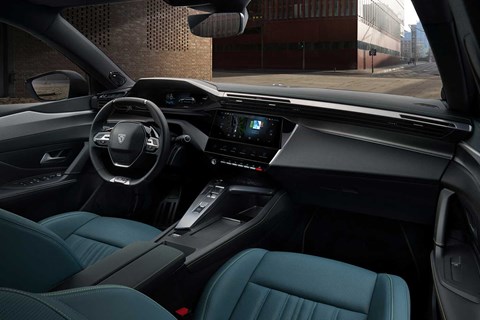
There’s also a plinth which offers up the EAT8 automatic’s rotary gear selector, a drive mode selector, and the start-stop button. Handbrake-turn fans should be aware that an electronic parking brake is standard.
Other notables include door panel inserts which can be finished in alcantara or aluminium, colourful ‘Adamite’ stitching, and a frameless windscreen mirror with a cyan-coloured LED on hybrid models. This apparently (virtue) ‘signals to the outside that the vehicle is being driven with zero emissions’, assuming the outside world is up to speed on minor Peugeot 308 spec details. Less cryptically, it also says ‘hybrid’ on the boot.
Driver assistance systems, an estate – but no ‘GTI’
Peugeot has seeded the latest driver assistance systems in the 308. Drive Assist 2.0 suggests lane changes for overtakes between 43mph and motorway speeds, keeps in line with changing speed limits and can throttle back your speed in curves if it senses the 308 is travelling too fast. These are all in addition to the usual assisted cruising stop/go and lane assist functions.
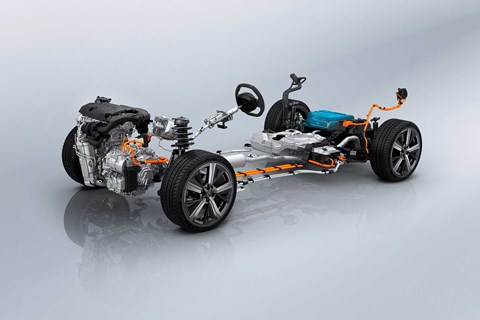
Other Peugeot upgrades include blindspot monitoring for up to 75 metres backwards and 360˚ parking assistance from four cameras. Plus from other Peugeots it carries over proximity sensing unlocking, automatic emergency braking (the basic system covers cars and pedestrians, advanced system adds cyclists and night function – and the radar is hidden behind the grille’s Lion emblem) and automated course correction if you veer towards the verge.
The hatchback won’t be flying solo for too long, with an SW estate confirmed for production. ‘We will show in a few months a very dynamic SW,’ says project leader Jerome Micheron. ‘It has what the customer wants – practicality, roominess – but I think you’ll be very surprised with the stance and design of the vehicle.’
But don’t hold your breath for Peugeot Sport to engineer a successor to the brilliant 308 GTI. ‘Due to CO2 regulations and taxes, we’ve seen the sales figures for dynamic versions like the GTI collapse,’ says Micheron. ‘The question in our strategy is: can we afford it and do we have the right solution for the sporty, dynamic segment? [The GTI as we know it] is totally disappearing with CO2 regulations.’